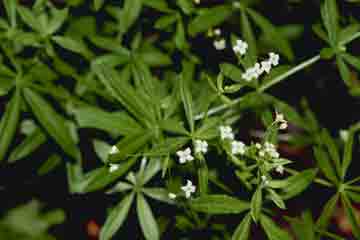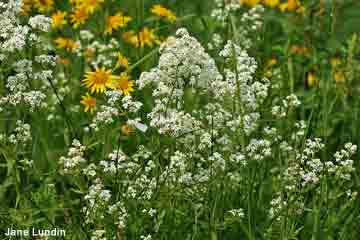Home | Next |
Previous | Index
| Purchase book
Idaho Mountain Wildflowers
Madder Family, Rubiaceae
Although only a few Rubiaceae grow in Idaho, the family is moderately
large, consisting of over 650 genera and some 13,000 species. Almost
all—trees, shrubs, vines and a few herbaceous plants—are tropical
plantss. Family characteristics include square stems, opposing narrow leaves
usually arranged as whorls at intervals along the stem, and small four or
five petaled flowers. Some contain important alkaloids: quinine
(Cinchona spp.) and ipecac (Psychotria emetica)—both from
South American trees; yohimbine derived from an African tree (Corynanthe
johimbe), used to treat impotence and as a topical vasodilator in surgery;
and coffee from the fruit of various species of Coffea (Africa). Some
of our most important garden ornamentals are also in the madder family:
Gardenia, Penta, Ixora, and others. Finally, the red dye madder from
which the family takes its common and scientific names—was also obtained
from species of Rubiaceae. The bedstraws (Galium spp.) are sweet smelling
Rubiaceae that dry to give a springy stuffing used in the past for pillows
and mattresses, whence their common name. “Cleavers” is another
name for bedstraws, one that conjures up mental pictures of a wicked kitchen
utensil. “To cleave” is an Old English word, however, one that
means “to stick” or “adhere” (cf. the injunction
“cleave unto me”), this because the seeds, stems, and branches
of some bedstraws easily attach themselves to passersby.
 |
Fragrant bedstraw, Galium triflorum
Michx. (left), scrambles along forest floors, climbing
other plants. Its bright green, narrow leaves form whorls at intervals along
the stems. Small four-petaled flowers, inconsistently borne in groups of
three (triflorum) at the end of long stemlets, arise at the leaf nodes.
They give off a sweetish grassy odor; one can understand how the dried plants
of this and related species might pleasant smelling bedstraw for pillows
and mattresses. The plant’s appearance is similar to that of the related
European herb, sweet woodruff or waldmeister (Galium odoratum Scop.),
that is steeped in white wine to make May wine.
Watson’s bedstraw, Galium watsonii
(A. Gray) A. Heller, (right) is an atypical galium, covered with long
bristly hairs. The plant blooms in the summer, favoring high dry
places. The flowers of most bedstraws are small and quite unremarkable.
This plant’s light yellow, four-petaled flowers are also small,
but long bristles originating on the flowers’ ovaries protrude
to give it a brush-like appearance (the plants are dioecious—the male
plants are not so hairy). The name Galium is derived from the Greek
gala for “milk” (cf. “galaxy” for the milky way),
because the European yellow bedstraw (Galium verum L.) curdles milk
and formerly was used as vegetable rennet in cheese-making, imparting the
plants’ yellow color to the finished product (nowadays rennet derived
from the lining of calves’ stomachs is used for the same purpose and
the yellow color is often an added food dye). |
 |
 |
Northern bedstraw, Galium
boreale L., is an ubiquitous
circumpolar plant found all through the United States (save a few southern
states), Canada, Greenland and Eurasia. The plants are many-branched with
four lanceolate leaves arising from stem nodes. Dense clusters (“cymose
panicles”) of small four-petaled white flowers are borne on stemlets
given off from leaf nodes at the top of the stems, producing, overall, a
showy profusion. The plants grow at all elevations, from sea-level to tree-line,
preferring moist situations. (The background yellow composites are a species
of Arnica.) |
Home | Next |
Previous | Index
| Purchase book


